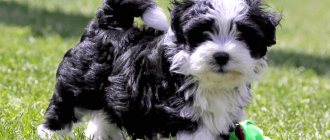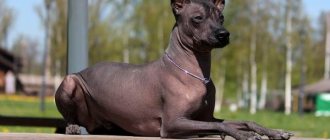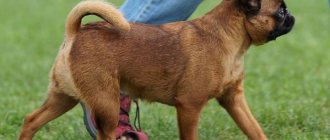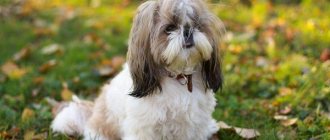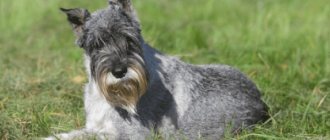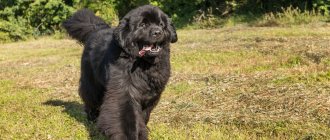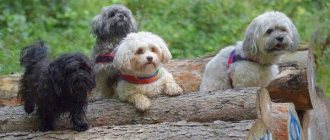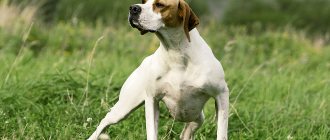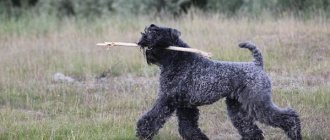History of the Havanese breed
Havanese Bichons are the national dogs of Cuba, which began their triumphal march around the world from the Canary Islands.
According to the official version, miniature pets were brought to Europe by Cuban immigrants. However, in fact, the opposite process took place. In the 16th century, Spanish sailors came to Liberty Island, with whom the first bichon-like dogs sailed there. Gradually, crossing with native Cuban breeds, the Spanish pets took shape into a unique breed type, which the locals dubbed blanquito de la Abana - “the little white dog from Havana.” For several centuries, the animals were loved by the Cuban nobility. They were housed in rich apartments, pampered in every possible way and taken abroad as living curiosities.
Unfortunately, the original type of blanquito de la Habana has not survived to this day. In many ways, the extinction of this amazing breed was facilitated by the Cuban Revolution: in the second half of the 20th century, dogs were exterminated en masse simply because they were held in high esteem by the local aristocracy. As a result, out of the entire clan of Havanese dogs, only a few individuals survived the change of political regime, some of which were already mestizos.
There is an opinion that during the military events on Liberty Island, eleven blanquitos were smuggled from it to the United States. In any case, when American breeders began to promote the idea of restoring the breed, there were several healthy and relatively purebred producers in the country. In the 70s, the “Havanese” living in America were infused with the blood of other decorative breeds, as a result of which the first representatives of the Havanese Bichon family were born.
If we are talking about the recognition of the breed by canine associations, then it came to the Havanese only in 1996. In Russia, the first puppies appeared even later - only in the early 2000s the first Cuban fluffies began to be imported into the country. To this day, the number of domestic bichons is extremely small, which makes it difficult to choose a healthy and impressive puppy in show or breeding type.
Appearance
The Havanese Bichon is a small but quite strong dog. The minimum height of an adult representative of the breed reaches 21 cm, and the maximum is 29. Moreover, the dog’s weight can range from 3 to 5.5 kg. An important parameter of the Havanese Bichon is the ratio between the length of its body and its height, which have a ratio of 4:3. And the length of the lap dog’s muzzle is equal to the distance between the occipital protuberance and the base of the nose.
The head of the Havanese Bichon has a round, slightly flattened shape. The transition from the broad forehead to the muzzle is quite pronounced. The lap dog's muzzle gradually tapers towards the black nose. The animal's thin lips fit tightly to its white teeth, which have a scissor bite. The dog's cheekbones are quite flat and practically do not protrude.
The Havanese's eyes, in comparison with its overall physique, appear large. They are almond-shaped and planted at a short distance from each other. The eye color is dark, but not black, but closer to brown. The dark edging of the eyes, which can be black or brown, of a dark shade, gives expressiveness to the animal’s look.
The Havanese Bichon's ears are set quite high. They hang freely along the animal's cheekbones and are of medium length. The tips of the ears are slightly rounded, and their entire area is densely covered with hair. The small compact head and slightly elongated body of the dog are connected by a short, strong neck.
The length of the body of the Havanese Bichon is slightly longer than its length at the withers. The dog's back is straight and slightly arched in the lumbar region. The dog's croup has a noticeable slope, and the stomach is well tucked, without sagging. The lapdog's tail is of medium length, set high and tucked behind its back. It is abundantly “furred” and has a dewlap consisting of long hairs of wool.
The Havanese Bichon's legs appear short in comparison to its overall build. The front and rear legs are straight and parallel to each other. They have strong bones and give the animal light gait. The dog's paws seem slightly oblong, they are small and gathered into a ball.
Coat and color
Wool is the main decoration of the Havanese Bichon. It is very long and extremely soft. The length of the top coat hair of a Havanese dog reaches 18 cm. The hairs can be straight or have a “wave”. Wavy hairs form beautiful curls that give the dog a special charm.
Long hair covers the entire body of the lapdog. On the neck and head of the animal, curls of fur create a mane that hides the transition from the head to the body. Often the long hairs of the coat cover the eyes of the lapdog, for which they are tucked into cute ponytails. The fur on the tail creates a chic dewlap, and the ears have feathering.
The Havanese Bichon breed is characterized by two types of coat colors. Pure white, the classic coat color is quite rare today, so the main color of animals is murugi of various shades. The color range of shades of this color varies from very light to brown and red. Spotted colors are characterized by the presence of light spots on the dark “fur coat” of the animal.
The Havanese Bichon is primarily a decorative breed of dog that is accustomed to the company of people and comfortable living conditions. The dog feels great both in a large and noisy family and as a companion for a lonely person. The lapdog, becoming attached to its owner, has a hard time withstanding loneliness, so this breed is not suitable for busy people.
The dog subtly senses the owner’s mood and will not bother you, demanding attention.
The Havanese is absolutely devoid of aggression and is not inclined to dominate other pets. If a pet already lives in the house, then he will definitely “find a common language” with the lapdog.
The Havanese Bichon will make friends with children and will happily share all their games. The only thing you need to worry about is that children do not offend the small dog.
Due to physical characteristics, a lapdog cannot be a full-fledged watchman. With its ringing bark, the dog will only signal the arrival of strangers. The dog treats strangers without aggression, but with distrust. Seeing that the person is friendly and does not pose a threat, the havanez relaxes and feels free. To prevent the dog from becoming overly fearful, early socialization is recommended.
The Havanese Bichon is a fairly intelligent dog that lends itself well to training and education. Representatives of the breed can often be seen in the circus arena, where dogs perform quite complex tricks. They take part in dog competitions and take prizes at animal shows. During training, the dog may show persistence and disobedience, which can be stopped with treats and a kind word.
Havanese Bichon breed standard
Havanez is a charming, frisky hairy guy who captivates your soul at first sight because of his spontaneity and pretty appearance. The height of the average representative of the breed is 23-27 cm, regardless of gender. If you have a secret passion for “bag” pets, get a Havanese Bichon without any hesitation!
With a wide range of colors to choose from, these shaggy Cubans look like they just walked off the red carpet from the hands of a Hollywood diva. Actually, half of the breed’s success lies in the glamorous exterior, while the rest rightfully belongs to the sociable, gentle character of the “Havanese”.
Head
The head length of the Havanese is approximately ⅓ of the length of its body. The skull can have either slightly rounded outlines or a flattened shape. If you look at the dog from the front or from the sides, the skull gives the impression of being square, while the cheekbones lack volume. The muzzle is not blunt or narrowed, the stop is very light.
Teeth, lips, jaws
The jaw closure is scissor-shaped. A complete dentition is desirable, but missing third molars and first premolars is still acceptable. Havanese Bichons have lips that are not fleshy and lie close to the gums.
Nose
Neat lobe in black or brown.
Eyes
The eyes are in the shape of large almonds with black or brown rims, as well as with a dark brown iris. The Havanese Bichon has a positive and friendly outlook.
Ears
The ears, covered with spectacular feathering, hang along the cheekbones and have a fold that slightly raises the ear flap. Standing moderately high, the tips are rounded. Ears not touching the cheekbones or semi-erect ears are undesirable.
Neck
The neck of the Havanese is of moderate length, the skin is well stretched.
Frame
The body is strong, with a flat and slightly convex back at the lower back. The croup is characterized by a strong slope, the stomach is tucked, and the ribs have a good bend.
Limbs
The legs of the Havanese Bichon are distinguished by strong bones, parallel stance relative to each other and general dryness of outline. An important nuance: the length of the forelimbs to the elbow should not exceed half the height of the dog at the withers. The paws are elongated, but compact, with tightly packed toes. The dog's movements are straightforward, springy and energetic.
Tail
The purebred Havanese has a tail thrown over its back or curved and carried high. The main decoration of this part of the body is a luxurious pendant made of long satin hair.
Wool
The Havanese Bichon's undercoat is either absent as such or poorly developed. The outer coat has a straight or slightly wavy structure and in mature individuals can reach a length of 12-18 cm. It is prohibited to shorten the dog’s hair in any way. Exceptions are allowed for hair on the paws and head, which can hinder movement and obscure vision.
Color
The traditional colors of the Havanese are white, white-biscuit, black, brown Havana, fawn of any degree of saturation, sable, tobacco, red-brown. White spots and slight tan are acceptable in all color types.
Disqualifying faults
- Height that does not fit within the boundaries specified by the standard (deviations within 2 cm are acceptable).
- Overshot or undershot.
- Nose with severe depigmentation.
- Entropy or ectropy. Depigmented eyelids.
- Any behavioral abnormalities, including unreasonable aggression and timidity.
- Cryptorchidism.
Pekingese
Pekingese are proud, moderately capricious and intellectually developed breeds. They are jealous and do not like to share their owner with anyone; they become very attached to him. But in general, this is a sociable dog that gets along well with all family members.
Pekingese weight is 4.5-5.5 kg, height is 18-23 cm, life expectancy is 12-15 years.
1 of 6
Excellent for indoor living, this is not a breed that needs long walks and physical activity. Pekingese can run and frolic, but only according to their mood.
Pekingese snores loudly and sneezes frequently, all due to brachycephaly (short muzzle)
The Pekingese's coat requires special care; it needs to be brushed and brushed more often to avoid tangles and to keep it overall looking beautiful.
Genetic diseases characteristic of this breed: cataracts, ectropion, respiratory disease, problems with the spine and musculoskeletal system, and heart failure.
Personality of the Havanese Bichon
At heart, the Havanez is a typical Cuban with his positively relaxed attitude to life and manic love for communication in any form. The sunny climate of Liberty Island and centuries of being a decorative breed have formed a number of qualities in the Havanese Bichons that distinguish them from other miniature tribesmen. For example, for their extraordinary craving for constant contact with the owner, “Havanese” are often called Velcro. Walking on the heels, poking a curious nose into all the secrets of the family, periodically begging for affection and tasty rewards - all these are classic habits of the Havanese Bichon, without which he immediately ceases to be a true Cuban.
One of the highlights of the breed is the ability to mirror the behavior and mood of the owner. A dog of a cheerful and active owner is unlikely to be melancholic, and a pet of an emotionally restrained owner will quickly adopt his attitude to life. As for the character traits of the breed as a whole, we can say that the Havanese Bichon is a real tsunami of friendliness and tenderness. The furry friend is able to get along with any creature, arranging races with the crazy cat or taking part in funny adventures invented by the children.
By the way, despite the external fluffiness and childish playfulness, the Havanese does not consider itself last on the hierarchical ladder. This character trait is especially pronounced in everyday communication. When in contact with its adored owner, the dog always tries to climb somewhere - onto a chair, someone’s lap, or at least onto an ottoman in the corner. All these manipulations are carried out with one single goal - to be on the same level as the person. However, such attempts to gain authority should not be confused with attempts to dominate. Competition for leadership is something Havanese Bichons have never heard of and something they would never want to do.
The loud, funny bark of the “Havanese” can be an excellent substitute for a home alarm system. By its nature, the breed is not very “chatty”, but it prefers to greet those who are not members of the family with its voice. The only caveat is that the havanez will bark at your friends and intruders with the same good-natured tenacity, so it will not be possible to understand by intonation who exactly violated the territorial boundaries.
The breed's secret passion is paper. It has not yet been possible to find out what exactly fuels this interest in animals, but leaving a havanese alone with a pile of documents or a roll of toilet paper, get ready for local chaos and the subsequent collection of cellulose scraps in all corners of the apartment.
Application
The Bichon is widely used as a companion dog for single people. A dog will brighten up the loneliness of an elderly person; in addition, close communication with an animal is beneficial for the owner’s well-being.
Kinestherapy is one of the newfangled branches of alternative medicine. Many balneological centers use the method of treatment by communicating with animals. The Havanese Bichon dog breed is considered the most promising in this direction.
The beneficial effects of contact with animals on the activity of the nervous and cardiovascular systems have been scientifically proven. In a family with children, the dog will become a friend in games, and sometimes in pranks. The dog is ready to have endless fun, which brings him closer to children. Although the Bichon is small in size, it can very well play the role of a watchman. A ringing and loud bark will warn the family that guests are approaching.
Education and training
It is better to take training the breed seriously, given that Havanese are smart pets that can handle complex training tasks. Preparing a puppy for upbringing and training is its socialization. Everything is simple here: the baby must get used to new living conditions, get to know family members and learn to consider them leaders of the pack. Remember that despite the lack of dominant habits, “Havanese” are rather cunning creatures who perceive any one-time concession as a pattern that must certainly be repeated.
Discipline your Havanese from the very moment you leave the kennel with him. In the first month after moving, the Havanese Bichon must get used to its bed, learn to accept its own nickname and eat according to the regime established by the owner. It’s better not to put off the issue of “toilet matters” until later, so, of course, stock up on disposable diapers for the first time, but put your puppy on the tray more often.
It is better to educate and train the Havanese at home, in the garden or in the yard. It makes no sense to take small representatives of decorative breeds to the training ground. Playing with contrasts is also not encouraged. According to dog handlers, the whip method not only does not work for miniature dogs, but also exposes their sensitive psyche to serious stress, so praise and treat your pet for successes, and turn a blind eye to failures.
If you want the havanez to respond to the call of all household members, introduce the names of family members into its vocabulary. Standard technique: put any small object in the bichon’s teeth, issuing the command “Take it to Sasha!” (the name of the person to whom the toy in the mouth is addressed is called). If the mentee understood you and fulfilled the requirement, be sure to praise him, and subsequently reinforce the new skill. Then start training from the very beginning, but with the participation of another family member. Don’t be surprised, the Havanese Bichon easily remembers human names; it just needs praise, treats and a moderately demanding teacher as a stimulating boost.
The Havanese is not a working breed; monotonous activities are a burden to him. The time limit for training lessons for Bichons is 5 minutes. The Havanese are simply not capable of concentrating attention on one action for a longer period of time. The same applies to teams. It is strongly not recommended to say one requirement more than three times in a row. Remember, the more often you ask your dog, the less he wants to listen to you.
Appearance of the Yorkshire Terrier
This miniature dog is quite strong and dignified. Its height from floor to withers is from 15.24 to 23 cm. Standard weight is from 1.81 to 3.17 kg (no more than 3 kg for exhibition specimens).
Puppies have black and brown coats that can be combined in different ways. As they grow older (usually at the age of 5-6 months), the black color gradually begins to acquire bluish tints, and the brown color becomes lighter. By the age of one and a half years, the Yorkshire Terrier's coat from the scruff to the base of the tail already has a dark bluish-steel color, and the muzzle, chest and paws are colored a rich golden fawn.
Frame
The Yorkshire Terrier is harmoniously built, its body has a proportional structure. He is quite muscular and elegant at the same time. The dog's back is quite short and horizontal. The height at the withers corresponds to the height of the croup
Yorkie's posture is proud, sometimes this little one looks touchingly important
Ears
Yorkie muzzle
The ears are miniature, V-shaped, erect, located not too far from each other, covered with soft short hair. The color of the coat is light golden.
Teeth
The Yorkshire Terrier is characterized by a scissor bite: the upper canines slightly cover the lower ones, and the incisors of the lower jaw are closely adjacent to the back side of the upper, forming a kind of lock.
Limbs
The Yorkie's front legs should be slender and straight, with no elbow bones protruding in or out. The hind legs, when viewed from the rear, should look straight; when viewed from the side, a slight bend is noticeable. The claws on the paws are black.
It is customary to remove dewclaws (dewclaus) on the hind legs, and at the request of the owners on the front legs.
Tail
The tail is traditionally docked to medium length. Cupping itself is not necessary. The tail is densely covered with hair, the color of which is darker and richer than that covering the body.
Wool
The pride of the Yorkshire Terrier is its thin, shiny, silky, completely straight coat, which is often called hair. In the classic version, it should be divided from the base of the skull to the tip of the tail and fall completely evenly and straight on both sides of the body, reaching the floor. In order for such a handsome man or beauty to always look impeccable, you will need to devote a considerable amount of time to them every day. This makes sense if the Yorkie is a participant in exhibitions, the hero of TV shows, or is invited to photo shoots. However, among the owners of such “super stars” there are many people who are simply selflessly devoted to this breed of dog.
Yorkshire Terrier after grooming
Most owners of Yorkshire Terriers prefer to cut their hair. There are several dozen haircut models: from simple to incredibly sophisticated. The procedures take place in grooming salons or at home with the invitation of a specialist. Sometimes short-haired Yorkshire terriers create a sensation no less than their long-haired relatives who look like aristocrats.
From time to time, a genetic leap occurs in the Yorkshire Terrier's nature. This is called the "return gene" or simply "return". In this rare case, your black-brown pet's coat will not turn bluish-gold as expected. The black color will remain that way, without any hint of blue, and the brown will turn into golden-red. This Yorkie is called Red Legged Yorkies, literally - red-legged Yorkshire terrier.
Maintenance and care
The Havanese Bichon spends most of its life in an apartment, so try to provide it with a comfortable and safe living environment. Think about how to prevent your pet from going out onto the balcony - perhaps it will be a special mesh or a high fence in front of the door. The same rule applies to household chemicals and a trash can in which the puppy can rummage. Also eradicate the habit of leaving detergents on the floor where your pet can taste them.
The Havanese is the ideal dog for homebodies. To relieve the “energy load”, jogging around the territory of his personal plot or two half-hour walks a day is enough for him. It is not recommended to “torture” the breed with exercise - the average Havanese Bichon is able to cover the need for physical activity by simply jogging in the company of its owner. By the way, in winter it is better to walk your dog dressed in insulated overalls. In frosty weather, Bichons get cold quickly and can catch a cold. At the same time, in summer, dogs do not need protection from ultraviolet radiation - their long, soft and well-ventilated “fur coats” are reliable protection against overheating.
Hygiene
The Havanese Bichon is a living anti-stress toy that needs to be hugged, squeezed and, of course, brushed more often. Since the breed has no undercoat, its representatives shed lightly, so there is no need to worry about the neatness of carpeting and upholstery. This, however, does not mean that you can afford to be lazy with havanese. If you don’t comb your dog’s hair at least once a week, very soon you’ll have to arm yourself with a razor and remove wool “dreadlocks” from your dog’s body.
It is recommended to bathe the descendants of blanquito only in case of urgent need, for example, when the animal looks unkempt. The breed does not require complex grooming, but if you notice that the hair on the forehead has begun to obscure the dog’s view, it is better to put it in a ponytail or slightly shorten it with scissors. Once a month, give your ward a pedicure, shortening the claws by a couple of millimeters. Since the Havanese does not suffer from excessive activity, their claw plate does not wear down when in contact with the ground. The first signal that it’s time for your pet to have its nails trimmed is its characteristic “clattering” gait.
Excessive lacrimation is a problem for the entire Havanese Bichon clan, so often go over the animal’s eyelid area with a clean cloth soaked in a strong chamomile or tea infusion. In white Havanese, the hair under the eyes often changes color due to tears. Accordingly, if you are the owner of a blond show pet, buy lightening talcs and coat powders.
It is better to examine the ears of a “Cuban” once a week. Take the time to pluck out the long hairs inside the dog’s ear funnel, otherwise the passage will be completely overgrown with hair, which will lead to deafness. You can remove lumps of wax from your ears using a piece of clean cloth and hygiene lotion from a pet store.
Havaneses have their teeth brushed 2-3 times a week. It is important to accustom your pet to this unpleasant process from puppyhood. If the silicone cleaning head causes extreme stress in your dog, you can use toothpastes that are applied to the teeth without a brush. Or, as an option, treat your dog more often with hard meat treats, which act as a gentle abrasive.
Feeding
US breeders rely on high-quality dry food, motivating their choice by the fact that dry-fed Bichons do not need to additionally select vitamins and dietary supplements. There are no strict feeding standards for the breed, but on average an adult Havanese consumes from half to a full cup of food per day. If we make more accurate calculations, then an adult weighing 4.5 kg must receive at least 400 kcal per day from food. For playful puppies under the age of six months with a body weight of up to 3 kg, the daily caloric intake of the diet is 467 kcal.
At the same time, it is important to control the weight of the fluffy dog, since the breed tends to build up its sides. A signal that it’s time for a Havanese to go on a diet is considered to be an undefined waist (when looking at the dog from above) and unpalpable ribs. Feeding frequency for healthy adults is twice a day. Puppies from 6 months of age eat three times, but by the age of one year they need to be switched to two meals a day.
In Russia, Havanese Bichons are often fed natural food. The list of dog preferences usually includes all those products that are recommended for consumption by any breed. Namely: lean meat, offal and offal, boneless cod fish fillet, low-calorie cottage cheese and kefir, chicken yolk, vegetables (except legumes, cabbage and potatoes), fruits (grapes and exotic fruits are prohibited).
It is not necessary to give your Bichon cereal to increase the nutritional value of the portion. This breed eats little and does not expend much energy. Havanese meat is cut into small pieces and served raw or lightly scalded. It is important to understand that with this approach to nutrition, purchasing ready-made vitamin and mineral complexes is an inevitable procedure. No matter how varied a natural menu may be, it will not be possible to completely fill the body’s need for minerals and trace elements.
Nutrition
A properly formulated diet will give your exterior a flawless appearance. You can feed your Bichon with dry industrial food, natural food, or choose a combined nutrition program. The diet of a four-legged pet must include:
- fresh fruits;
- boiled vegetables;
- lean meat (poultry, beef);
- sea fish without bones;
- dairy products;
- cereals (risk and buckwheat in meat broth);
- vitamin and mineral supplements.
It is forbidden to feed the Havanese Havanese:
- food from the table;
- sweets (sweet rolls with cream, sweets, gingerbread);
- sausage and frankfurters;
- spices;
- fatty meat;
- fish without heat treatment.
Premium dry dog food
Rating
Holistic dog food
Rating
Small breed dog food
Rating
Health and illness of the Havanese
Havanese Bichons are long-lived dogs, often celebrating their 14th and 16th birthdays. Experts monitoring the development of the breed continue to work to eradicate genetic diseases among its representatives, but so far hereditary diseases have not been completely defeated. For example, the most common problem among today's Havanese is a dislocated kneecap. Diseases such as retinal dysplasia, cataracts, heart and liver pathologies, Perthes disease, deafness, and chondrodysplasia are also inherited.
Summarizing
The Havanese Bichon is a companion, a loyal friend, who cannot imagine his life without his owner. These dogs will suffer when left alone, so before purchasing a puppy, you need to consider whether family members will have the opportunity to regularly spend time with the dog. Another difficulty is the long hair of the Bichon, which you need to regularly care for yourself or visit a groomer.
Havanez, despite his modest size, has the heart of a lion and will not offend those he loves most in the world - his family. In general, this is an excellent breed for those who love walks and moderate activity; the dog will not take up much space at home and is perfect for the role of a pet in a small apartment.
How to choose a puppy
- The number of Havanese dogs in Russia is still small, so pay great attention to choosing a nursery. As an option, take a ride through the Baltic countries, where the breed began to be bred a little earlier.
- Try to communicate with the puppies' mother and the rest of the litter. Pay attention to how the Bichon you like behaves with its fellow tribesmen - whether it leads or obeys.
- Test the puppies for friendliness. Lift the little furry off the floor and evaluate his actions. If your baby squeals and tries to bite you, this is a sign of an unstable psyche. Remember, the Havanez is not a “servant”, and it is unusual for him to show aggression.
- Ask the seller not only for the pedigrees of the producers, but also for the results of their examination for hereditary diseases. In particular, for elbow and hip dysplasia.
- Always give importance to the appearance of the offspring. Puppies should be well-fed, with clean, smooth fur, without signs of an umbilical hernia or signs of diarrhea under the tail. Uniformity of the litter is encouraged, and one puppy will always be larger than the rest.
Yorkshire Terrier
Today, Yorkshire Terriers are popular thanks to many celebrities who post photos with their cute pets. Height up to 20 cm at the withers and weight within 3 kg really allow you to appear everywhere with this dog and even carry it in your bag. But people should not forget that the breed was originally bred as rat catchers, so a brave heart beats in the small body of the Yorkshire and the hope that all his abilities will be in demand by the owners.
Despite their ostentatious independence, Yorkies try to keep their owner in sight and, if they do not detect him, become worried
But owners are primarily attracted by the special fur of these dogs, which is similar in structure to human hair. This gives housewives the opportunity to try themselves as stylists, creating a variety of hairstyles for their pets.
Yorkshire Terriers require early socialization, otherwise the pet will grow up either excessively cowardly, or irritable and aggressive.
Havanese Bichon price
It is believed that the most promising Havaneses should be looked for in the USA, although American breeders are not eager to send puppies with excellent exterior characteristics abroad. As for the cost, you won’t be able to buy a purebred Havanese Bichon in the States for less than $1000-1500. Havanese dogs from Russian nurseries are cheaper - from 30,000 rubles for a pet-class puppy. It is better not to respond to offers with a lower price tag that are found on virtual bulletin boards. In most cases, they are placed by sellers of mixed breeds and undocumented animals.
Socialization
Thanks to their loving nature and playful disposition, Bologneses get along well with other pets. And it doesn’t matter whether they grew up together or appeared in the house at different times. For the Bichon, the most important thing is src=»https://dogipediya.ru/wp-content/uploads/2019/01/gavanez-4.jpg» class=»aligncenter» width=»583″ height=»480″[/img ]
The Havanese Bichon is better with children than other dog breeds. But it is more desirable if the child is a schoolboy. Due to his age, the baby is not able to calculate his strength and may accidentally harm the dog. She, in turn, will yap or even bite lightly.
Theses
- A typical companion dog that cannot imagine life without a person. They suffer greatly from loneliness if they are left alone for a long time.
- The Havanese's long, silky coat is beautiful, but requires regular grooming. Most owners prefer to cut it, but if you have a show dog, it is better to resort to grooming services.
- They feel good in all types of housing, from an apartment to a private house with a large yard.
- They will bark if someone approaches the door or passes the gate. The good news is that they don't bark just to hear their own voice.
- They love to look at the world from above, for which they climb onto sofas and tables.
- They love children and get along well with them. Usually these are best friends.
- Average activity, but needs walks and games.
Choosing a nickname
The source of inspiration is the names of celebrities, historical figures, mythological and literary heroes, geographical names and even the character and appearance of the pet. Choose a loud, clearly pronounced name that won't bother you after you've called your dog for the twentieth time that day.
| Suitable for girls: | Audrey, Sarah, Klepa, Missy, Luna, Camry, Vesta, Belka, Nusya, Ganga. |
| For men: | Guy, Ollie, Jerry, Rain, Fet, Drona, Brom, Queen. |
